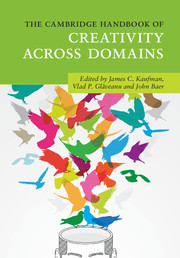Book contents
- The Cambridge Handbook of Creativity Across Domains
- The Cambridge Handbook of Creativity Across Domains
- Copyright page
- Dedication
- Contents
- Figures
- Tables
- Contributors
- Acknowledgments
- Part I Creativity and Domain
- Part II Creativity in the Traditional Arts
- Part III Creativity in the Sciences
- Part IV Creativity in Business
- Part V Newer Domains for Creativity Research
- 24 Intellectual Property
- 25 Gastronomy and Culinary Creativity
- 26 Tactical Creativity in Sport
- 27 Creativity in Non-Human Animals
- 28 Violent Innovation
- Part VI Creativity in Everyday Life
- Part VII Conclusion
- Index
- References
25 - Gastronomy and Culinary Creativity
from Part V - Newer Domains for Creativity Research
Published online by Cambridge University Press: 15 September 2017
- The Cambridge Handbook of Creativity Across Domains
- The Cambridge Handbook of Creativity Across Domains
- Copyright page
- Dedication
- Contents
- Figures
- Tables
- Contributors
- Acknowledgments
- Part I Creativity and Domain
- Part II Creativity in the Traditional Arts
- Part III Creativity in the Sciences
- Part IV Creativity in Business
- Part V Newer Domains for Creativity Research
- 24 Intellectual Property
- 25 Gastronomy and Culinary Creativity
- 26 Tactical Creativity in Sport
- 27 Creativity in Non-Human Animals
- 28 Violent Innovation
- Part VI Creativity in Everyday Life
- Part VII Conclusion
- Index
- References
Summary
Development of creativity and innovation in culinary art is a continuous process which brought us the diversity of current food and cuisines. From the nouvelle cuisine in the 1970s to fusion cuisine and molecular cuisine, various innovations suggested that culinary creativity is closely integrated with culture, art, science, and technology. This chapter is going to review the characteristics and evaluation principles of the Four Ps of culinary creativity (creative culinary person, creative culinary process, creative culinary products, and environmental factors (places)) affecting culinary creativity. Also, this chapter points out trends of culinary creativity to serve as references for chefs now and in the future. Such trends include green gastronomy, health-improved culinary, new technology application, and culinary localization and globalization.
- Type
- Chapter
- Information
- The Cambridge Handbook of Creativity across Domains , pp. 462 - 478Publisher: Cambridge University PressPrint publication year: 2017



